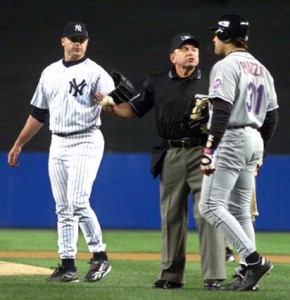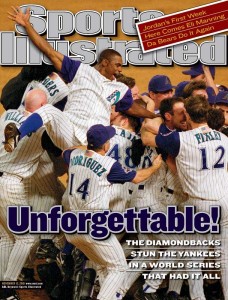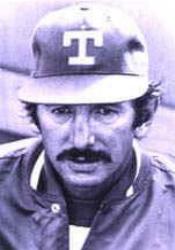Baseball book-review three-pack: American Icon, The Last Nine Innings, and Seasons In Hell
 American Icon: The Fall of Roger Clemens and the Rise of Steroids in America’s Pastime is the work of four writers (Teri Thompson, Nathaniel Vinton, Michael O’Keeffe, and Christian Red), and you can kind of tell.
American Icon: The Fall of Roger Clemens and the Rise of Steroids in America’s Pastime is the work of four writers (Teri Thompson, Nathaniel Vinton, Michael O’Keeffe, and Christian Red), and you can kind of tell.
The tone slips in and out of a few different gears — here formal and distanced, there caustic and irreverent — and occasionally one journalist seems to step into another’s way. For example, on page 370, with regard to the February 2008 Congressional hearing (the absorbing account of which is the book’s highlight), we are told, “[T]he conventional wisdom was that the Democrats sided with McNamee while the Republicans sided with Clemens. This was a rather simplistic analysis of what transpired.” The book then goes on to make its case convincingly by citing personal exceptions and gray shades.
Unfortunately, not 20 pages earlier (354), American Icon had propagated that simplistic analysis: “The 2005 hearing with McGwire was […] a genuinely bipartisan effort. Republicans and Democrats couldn’t agree on Iraq or taxes, but they could join together to verbally slap around Bud Selig and Donald Fehr. But by February 13, 2008, even steroid bipartisanship was ancient history, and the hearing […] was as polarized as everything else in Washington. By the end of the day, Roger Clemens, evolution, and gay marriage had at least one thing in common: They were all issues in America’s Blue State-Red State culture wars.” As the tapestry of previously published New York Daily News columns that I suppose this largely is, it is quite skillfully done (a close follower of that periodical would know better than I how much here is fresh), but it never entirely shakes off that synthetic, by-committee quality.
Still, if you are going to pony up for one or the other of this spring’s hardcovers with Clemens’s name in the title — or, indeed, read one or the other in any format, anywhere down the line — I would recommend this one well ahead of Jeff Pearlman’s conventional and rather glib birth-to-present bio. American Icon deals only incidentally with Clemens’s life pre-Jays, focusing tightly on his (alleged, I suppose we still must say) steroid years and the recent collapse of his reputation. For all that, it is persuasive in the picture it presents of his personality (both Pearlman and the Daily News quartet make much of the theory that what made Clemens a successful pitcher — the doggedness, the unwillingness to “give in,” etc. — ultimately has doomed him in his response to the airing of his dirty laundry).
The scope is wider, though. Though Clemens is more focal than any other player and appears on both covers (his right hand holding a Piazza-directed bat shard on the front, then raised for an oath-taking on the back), Icon ultimately is more of a companion piece to Mark Fainaru-Wada and Lance Williams’s Game of Shadows and Howard Bryant’s Juicing The Game: weighty and troubling morning-after reading for the steroid era.
If it fails to satisfy you in every other respect, I can assure you that you will not go away wanting to learn more about the June 1998 post-Winstrol abscess on the Rocket’s right buttock (the index entry for which reads as follows: ix, 17-18, 32, 146, 177, 181, 188, 236, 237, 240, 246-7, 300-1, 303, 306-8, 310, 335, 348, 349, 368-9, 393, 401, 426).
— by Todd K
 *****
*****
The Last Nine Innings: Inside the Real Game Fans Never See takes as its subject the seventh game of the 2001 World Series, while also tracing each storyline that led there: players, previous games in that Classic, 9/11, and more. That sort of book is an invaluable addition to a baseball library if it’s done well (Hernandez’s Pure Baseball), but deeply trying if it isn’t (Bissinger’s Three Nights in August), and the potential pitfalls would seem both deeper and more numerous here: the number of future Hall-of-Fame pitchers under discussion alone, plus a Yankee team that 1) had to carry the mantle of a nation’s grief and 2) represents, in romanticized retrospect, the end of a dynasty blah blah blah Brosius-cakes.
To my relief, Charles C. Euchner brandished the match that would dispel that fart on page xiv:
Contrary to essayists like Jacques Barzun and George Will, baseball doesn’t provide the most telling lens into the American psyche. But baseball is a damn good game, and sometimes it unfolds in ways that astonish and please even cynics. Sometimes, because it can astonish and please, the game creates something that seems bigger than it really is. And people sometimes need something that seems bigger than it is.
Euchner walks that tightrope throughout the book, and the prose is mostly notable for what it doesn’t do. It doesn’t ascribe deeper meaning to routine plays made by good-but-not-great Yankees past who have since come to symbolize “true” Yankee-dom to the frustrated local sports media. It doesn’t take irrelevant sidebars; the supporting information in each chapter, whether about pitching mechanics or AL managers trying to readjust to the pitcher batting, is not uniformly fascinating, but it’s edited with intent.
Unfortunately for Euchner, the book came out in 2006, and spends a large portion of the “The Science of Pitching” chapter explaining Roger Clemens’s longevity in terms of his mechanics:
But Clemens’s success cannot be explained by saying he’s a freak. The answer is much more profound. Medical researchers at the Birmingham campus of the University of Alabama have found that the secret to Roger Clemens’s power and longevity can be found in the exquisite perfection of his pitching motion. (113)
…Oh, is that where they found it.
I don’t think Euchner is whistling past the graveyard here; he had a point to make about what separates great pitchers who enjoy long careers from the majority who go down with irreparable elbow problems after only a few years in the show, and Clemens seemed to make that point in ’06. It’s ’09 now, so I skipped most of that chapter.
Euchner is probably to blame for the many quotations from Tim McCarver, most of which — like his present-day on-air “observations” for FOX Sports — make sense until you repeat them aloud to yourself. The sadness of this, to me, is not that McCarver is the Governor of Vacuous Truthsylvania, although he is, but that he used to have something to say back in the day when he was in the booth for the Mets. Maybe it just seemed like he did because, unlike Ralph Kiner, he could remember the players’ names, but he doesn’t even enjoy that advantage anymore (“Brandon Arroyo,” your table is ready), and if he did, he’d bury it in garbage like “Nobody can relate to a walk like Barry Bonds” (136), “Schilling and Clemens can be different from Schilling and Clemens of a different day (ibid.), and “It’s part of the delicious minutiae of baseball — except that it’s not minutiae, it’s huge in the context of the game” (172). That last one is museum-quality McCarver. “It’s just one of those little things, but it’s actually really big, but it’s only big in context.” Jesus H. McGillicuddy.
 But other citations make up for this, and as a fan of the Yankees who watched, stricken, as the team got beat, the narrative’s focus on field-level decision-making and behind-the-scenes information takes the sting out. Euchner is not the most graceful stylist — the physical comparison of Paul O’Neill to the Man in the Yellow Hat from Curious George is not astute enough for one use, much less the two in the text — but he gets out of the subject’s way most of the time. It’s a bit more about the Yankees than it should be and a bit dated in its approach to some of the players, but still a solid-B effort for readers who like pitch-by-pitch-type analysis.
But other citations make up for this, and as a fan of the Yankees who watched, stricken, as the team got beat, the narrative’s focus on field-level decision-making and behind-the-scenes information takes the sting out. Euchner is not the most graceful stylist — the physical comparison of Paul O’Neill to the Man in the Yellow Hat from Curious George is not astute enough for one use, much less the two in the text — but he gets out of the subject’s way most of the time. It’s a bit more about the Yankees than it should be and a bit dated in its approach to some of the players, but still a solid-B effort for readers who like pitch-by-pitch-type analysis.
— Sarah D. Bunting
*****
Mike Shropshire on the aftermath of Billy Martin’s firing as Detroit manager in 1973: “Martin and [Tiger GM] Jim Campbell did not part as friends. For the next two years at least, Billy, in polite company, liked to excuse himself, head for the john and announce, ‘I’ve gotta go take a Jim Campbell.'” The funniest part of this bit: the idea that Billy Martin spent any consequential time in polite company.
Shropshire’s Seasons In Hell: With Billy Martin, Whitey Herzog and “The Worst Baseball Team in History” isn’t the highest-browed humor you’ve ever read, but if you liked Ball Four, you’ll like Seasons In Hell. The eyewitness account of the notorious 10-Cent Beer Night in Cleveland is excellent, as is Shropshire’s side of a series of dust-ups with Jimmy Piersall (at one point Shropshire, afraid for his life, takes the offensive during a Piersall rant and orders him to keep his voice down in the press lounge: “Can’t you see? People are trying to drink in here!” Meanwhile, behind Piersall, a Star-Telegram photographer has picked up a knife, “just in case” — it’s funnier than I’ve made it sound, especially if you know anything about Piersall).
I’d have liked a straighter-faced look at the David Clyde situation, but there isn’t really all that much more to say about it, I suppose, and as written, the book is well paced, knowledgeable, and frequently outright hilarious. It’s as much a snapshot of early-to-mid-seventies journalism culture as it is a baseball book; you can read it in a day, and even non-fans will get something out of it (the writing is like Joe Queenan but less hit-or-miss). And you can’t beat the photo of Ranger owner Bob Short’s sportcoat, which looks like an old-school screensaver.
— Sarah D. Bunting
Tags: abscesses bad baseball writing Billy Martin Bob Short books Bud Selig Buzz Bissinger Charles C. Euchner Christian Red Curious George Curt Schilling David Clyde Donald Fehr friends Howard Bryant Jim Campbell Jimmy Piersall Joe Queenan Keith Hernandez Lance Williams Mark Fainaru-Wada Mark McGwire Michael O'Keeffe Mike Piazza Mike Shropshire Nathaniel Vinton Paul O'Neill Ralph Kiner Roger Clemens Scott Brosius shut up Jeff Pearlman Teri Thompson Tim McCarver Whitey Herzog





Sars – have you read Alyssa Milano’s “Safe At Home” yet? She seems to be a hardcore baseball fan and am interested if you think her book is any good.
@Mike: I’m not willing to spend money on it, so no. I’m not sure how knowing a few baseball players in the biblical sense means she knows anything about the game itself, but I’m probably jus’ jellus she got a book deal to write about it and I didn’t. (“…Yet!”) If I can find it on Half.com for under a buck, I might give it a shot.
I actually sat next to an author or editor of this on a plane some months back–he was marking up proofs on a flight to LAX, and I noted the title and thought “I bet Sars ends up doing a post on this.” Kinda tickled I was right.
And by “this” I meant American Icon. Gah.
I admired Buster Olney’s similar inning-by-inning book on the 2001 WS Game 7 (The Last Night of the Yankee Dynasty), but it has become dated in precisely the same way: all the material on Clemens’s miraculous longevity, including the requisite nyah-nyah at Dan Duquette for the “twilight” remark, as well as details of the medical research cited by Euchner (Olney, p.97: “[RC] had once gone to Birmingham, Alabama, to be tested at the American Sports Medicine Institute’s laboratory, where the cameras surrounded him and recorded his motion in minute detail. Glenn Fleisig, the director of research, who had pinpointed flaws in the mechanics of thousands of professional and amateur pitchers […] found Clemens to be entirely exceptional. Each piece of his delivery was in almost optimal position.”).
Another recent book that makes something really lovely and atmospheric of the Nine Innings narrative style (enough that I do not mind its carelessness on dates, right/left field confusion and other incidental errors — baseball is not this author’s usual beat) is Richard Bradley’s The Greatest Game: The Yankees, The Red Sox, and The Playoff of ’78.
McCarver is a good example of what happens when people try — and fail — to imitate the Zen koans of Yogi Berra.
So glad I’m not the only one who remembers McCarver’s Mets broadcasts, back when he seemed to know what he was talking about!
Also – my favorite Kiner’s Korner moment: Ralph’s heroic attempt to interview Keith Hernandez and Sid Fernandez at the same time. He didn’t get either name right once, even by accident. Brilliant!
I think there should be 2 major leagues….a steriod version with 500 foot fences and a normal version. At least we would know what we were getting….or how about this?… publish in the game programs that: “Today, Manny Ramirez will be playing under the influence, place you bets accordingly.”…just like a horse on lasix. It’s all about the entertainment these days…sad.
I find it very amusing that I read that first as, “a horse on lasik,” and I’m like, “Damn, how do they even know if a thoroughbred’s vision is a little blurry?!”
This site–along with the Rays finally moving up into the majors, heh–is making me a baseball fan. Which is cool, because for all the time I spent with the excuse, “I just don’t know any baseball fans,” I made like five random bar-friends watching the Rays/Yankees series this weekend. Good stuff.
There was a televised Red Sox game last season in which McCarver drawled, re: Jacoby Ellsbury, “He’s a good-lookin’ ballplayer,” and later “That is one good-lookin’ ballplayer!” I imagined Jeter hearing about it and sobbing, “They always said he’d trade me in for a younger model someday…”
On the David Clyde tip, a story in the current SI — an oral history from some of the #1 draft picks — has some interesting comments from him: http://vault.sportsillustrated.cnn.com/vault/article /magazine/MAG1156472/index.htm